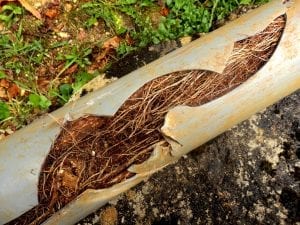
Help! I've Got Tree Roots in My Sewer Line!
"Those darn trees!" "Cut em' down, cut em' all down!" These are all common phrases we frequently hear from frustrated homeowners after experiencing a sewer backup. What many homeowners don't realize is that cutting down that tree will not necessarily put an end to tree roots in sewer lines.
For starters, it is not just large trees that can cause a root problem, as roots from nearby bushes and shrubs also extend down deep enough to sneak their way into your sewer line. Additionally, even though you cut a tree down, the roots still continue to grow underground for several years. So what can you do? Once roots have found their way into your sewer they will remain there if no action is taken. But fear not - there ARE ways to control them and there’s even a way to stop them permanently.
Chemicals
There are many different chemicals on the market but in most cases you are literally throwing your money down the drain. Most roots grow into your sewer from the top and the sides of the pipe. Any chemical of either a liquid or granular nature will flow on the bottom of the pipe along with the water, and therefore, will never come fully in contact with the majority of the roots in the line. The only chemicals that should be used are that of a foaming nature because they foam up when poured into the sewer as it travels through the pipe. Since the foam swells up throughout the entire pipe, it comes into contact with some of the roots. The biggest thing to keep in mind with chemicals is that this is only a temporary fix for your root problem. They may grow back a bit slower (and possibly not as aggressively) but they will still be there.
Periodic maintenance
Periodically having your sewer rodded by a professional can help keep the growth of the roots in your sewer to a minimum. You may want to do it yourself. You certainly can, but keep in mind that many rental companies do not rent sewer cleaning machines with larger cutting heads and instead they provide a smaller one, in fear that the larger one will get stuck in your line. These smaller heads do not clean the sewer as effectively as the larger ones do. Many sewer cleaning companies offer yearly or bi-yearly preventative maintenance sewer rodding programs and send reminders when you’re due for the maintenance work. Some companies even offer discounts for participating in these programs. An annual preventative sewer rodding program prevents unexpected backups and the headaches that come along with them.
Sewer replacement
Sewer replacement involves digging up a portion of, or the entire length of your sewer. This method is costly and pretty destructive to nearby landscaping and property. Oftentimes, sewers are located six feet or more underground so digging a trench to expose and replace the existing line means bringing in heavy equipment to do so. Additionally, if your sewer runs under a driveway, sidewalk or a street this means that the old dirt must be removed and new backfill must be brought in to restore the surface to its pre-dig condition. These restoration costs sometimes double the cost of the actual job of replacing the sewer.
Sewer lining
Sewer lining consists of installing a flexible liner on the inside of your old sewer. The liner is coated with a hardening resin that, once cured, creates a new pipe within your old pipe. The liner has no seams or joints to allow roots in and in most cases, it is installed through existing cleanouts. So what does this mean? It means absolutely no digging, no destruction to your landscaping or property and no costly restoration fees! While the cost of lining seems comparable to the cost of a traditional dig, it is actually more cost effective because you will not have the expensive restoration fees after lining that you would have with a traditional dig. This alone saves you thousands of dollars. Liners also come with a pretty nice 50 year warranty, so it’s an ideal long-term solution to your root problems. As an added bonus, you will also gain peace of mind knowing you no longer have to periodically clean your sewer or experience untimely backups any longer.
Sure tree roots in your sewer are annoying but don't cut down that nice tree just yet. The bottom line? Know that you have options. The best thing to do is have your sewer televised with a video camera by a professional and reputable sewer company. This allows you to see just what the condition of your sewer line is from the inside and this extra information helps you make a more educated decision on what the best course of action will be to minimize or eliminate your root problem
